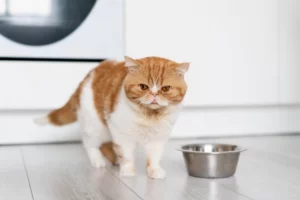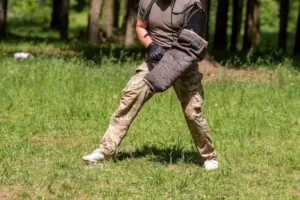Cats “hit” you with their tail for a few common reasons: play/attention-seeking, irritation or stress, or overstimulation while being petted. A quick, sharp tail swish or thump usually says “give me space,” while a relaxed swish during play is normal. Watch the whole body, ears back, pupils wide, or a lashing tail = stop petting and let your cat cool off.
| Cat Tail motion | What it mean | What to do |
|---|---|---|
| Gentle swish while playing | Excited/engaged | Stop petting; let the cat retreat. |
| Quick flicks / thumping against you | Irritated or stressed | Pause interaction; give space. |
| Vigorously thrashing | Upset/angry; may escalate | Quick flicks/thumping against you |
| Upright “question-mark” tail | Friendly, playful mood | Offer interaction on their terms. |
| Tail lashing during petting | Petting-induced overstimulation | Keep play short; offer a toy as a target. |
Why Does My Cat Hit Me with Her Tail?
Cats are fascinating creatures with a complex and nuanced form of communication. They rely on a variety of cues to express their emotions and intentions, and one of the most notable is their tail.
If you’ve ever thought, “Why Does My Cat Hit Me with Her Tail?” you may wonder what it means.
In this blog, we will explore the reasons behind this behavior and unravel the mystery of why your cat hits you with her tail.
What does it mean when a cat hits you with their tail?
- Play/attention-seeking: soft swishes during play or approaches with a high “question-mark” tail. Invite toy play instead of hand play.
- Irritation/stress: rapid flicks or thumping against you are a request for space. Pause interaction and let them choose when to re-engage.
- Strong lashing: a clear “back off”—risk of escalation. End petting and let your cat settle.
Top 5 Reasons Why Your Cat Hit You with Her Tail
1. Your Cat Wants to Play with You
One common reason why your cat may hit you with her tail is simply because she’s feeling playful.
During moments of excitement and high energy, cats may wag their tails rapidly or deliver gentle tail flicks as they engage in interactive play.
If your cat is swatting you with her tail during playtime, it’s a clear sign that she’s having fun and enjoying the interaction.
Recommended Products for Your Cat

VOLUAS Automatic Cat Feeder

PETLIBRO Automatic Cat Feeder

PETKIT Automatic Cat Feeder with Camera
2. Your Cat is Annoyed
Cats are known for their independent nature, and they value their personal space. If your cat is hitting you with her tail, it might be her way of expressing agitation or annoyance.
She may be signaling that she’s feeling bothered or doesn’t want to be disturbed at that moment. Pay attention to her overall body language and respect her boundaries.
3. Your Cat is Stressed
When cats feel frightened or anxious, they often display defensive behaviors, and tail movements can be a part of it.
If your cat’s tail swishes vigorously or hits objects, including you, it could indicate fear or stress. Take the time to identify and address any potential sources of anxiety in your cat’s environment to help her feel more secure.
4. Your Cat is Excited
Cats can also hit you with their tails when they’re excited or anticipating something. For example, if your cat knows it’s time for her favorite treat or play session, she might show her enthusiasm through tail movements.
These excited tail flicks are usually accompanied by a lively demeanor and an overall sense of anticipation.
5. Your Cat is Angry
Although rare, aggressive behavior in cats can manifest through tail thrashing or hitting. If your cat’s tail movements are accompanied by other signs of aggression like hissing, growling, flattened ears, or a puffed-up body, it’s crucial to address the issue promptly.
Consult with a veterinarian or a feline behaviorist to better understand the underlying cause and develop a suitable plan to manage the aggression.
Read Also
- How Long Does Dry Cat Food Last
- How To Make a Homemade Dog Bite Sleeve? Easy DIY
- Can cats eat sausage?
What to do in the moment (owner checklist)
- Stop petting at first flicks/thumps.
- Scan ears, eyes, and posture for stress.
- Switch to toy play if they’re energized.
- Space: let your cat leave; invite later.
Frequently Asked Questions
Why does my cat hit me with her tail when I pet her?
Some cats develop petting-induced (overstimulation) aggression. Signs often appear seconds before a swipe: tail lashing, skin ripples, ears back, pupil dilation. Keep sessions short, pet the cheeks/head (not back or belly), and stop at the first tail flicks.
Is my cat hitting me with his tail on purpose?
Tail swats are communication, a way to control when contact starts and stops. Respecting that signal reduces conflict and builds trust.
Why does my cat smack/slap/whip me with her tail or in the face?
That stronger language usually tracks to irritation, fear, or frustration. Step away, lower stimulation, offer a play outlet, and re-try later.
When does tail hit mean stress or pain?
If tail-hitting is new, frequent, or paired with hiding, appetite change, or grooming avoidance, rule out pain or anxiety triggers and speak with your vet.
Conclusion
Understanding your cat’s tail language can provide valuable insights into her emotional state and overall well-being. While tail hitting can have different meanings based on the context and your cat’s personality, it’s essential to observe her overall body language and consider the situation.
By paying attention to these cues, you can deepen your bond with your feline companion and ensure her needs are met, leading to a happier and more harmonious relationship.
Remember, each cat is unique, and by decoding their tail language, you’ll become better equipped to provide the love and care they deserve.





